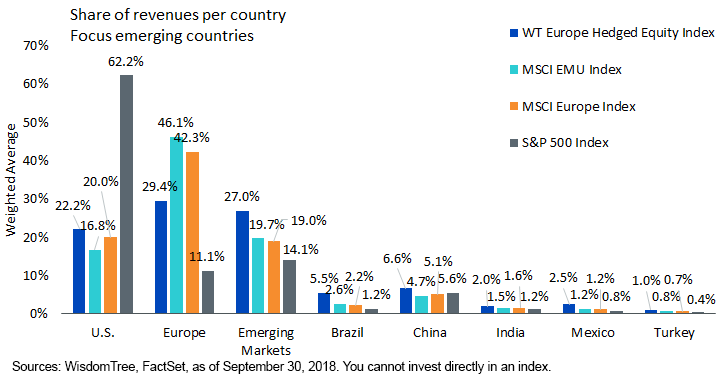Emerging Markets With Lower Risk? Think About Europe
2018 has been a challenging year for emerging market equities, coming on the back of 2017, which was quite strong. Some observations on the current environment:
- Year-to-date, emerging market equities are down 8.8% in U.S.-dollar terms. Nearly 5% of this cumulative decline came from the U.S. dollar strengthening against emerging market currencies.
- As of this writing, the U.S. 10-Year Treasury yield has eclipsed 3.2%. While a lot of the U.S. Federal Reserve’s (Fed) rate hike policy was priced into the dollar’s level, we’ve seen it respond much more strongly to rising interest rates further out on the yield curve. In short, a sharp upward move in the 10-Year Treasury, in the current environment, seems to have more weight than what the Fed is doing, giving us a further catalyst for dollar strength.
- It has been an interesting year to watch the price of a barrel of Brent Crude oil, more than $86 as of this writing. Certain emerging markets are closely geared to the price of Brent Crude, so amid a challenging year, you can see total returns for Qatar (+20.74%), Colombia (+9.47%) and Russia (+9.41%) on the one hand, and South Africa (-24.31%), Greece (-29.41%) and Turkey (-45.82%) on the other.1
Despite the Rhetoric, Global Trade Continues to Exist
Even with what is sometimes termed a “global trade war” going on, it is important to remember that today’s world is extremely globalized. Yes, there has been tension, but the goal of that tension is to make deals, like the recent United States-Mexico-Canada Agreement (USMCA). Change is difficult to digest at times, but global trade won’t be going away.
If one thinks of the S&P 500 Index, which is made up of companies that derive less than two-thirds of their weighted-average revenues from inside the U.S., it evidently has massive global exposure. Some might even argue that these firms are so globally exposed that international investments aren’t needed.
Valuation Remains Important
The risk of avoiding international investments is that there may be valuation opportunities beyond one’s home market. Over long periods of time, one of the most important drivers of return comes from one’s starting valuation. Emerging market equities continue to be one of the least expensive regional equity markets in the world.
The Rise of Revenue-Based Investing
If there was a way to balance a business exposure to emerging markets with the equity market volatility of a more developed region, that could create an interesting compromise between risk and revenue exposure.
The WisdomTree Europe Hedged Equity Index requires that each qualifying constituent have more than 50% of its revenue from outside Europe. In fact, this was WisdomTree’s first Index to have exposure to a particular market (Europe) while also ensuring that constituents are exporters and globally oriented. It is an example of how index construction has changed the game, lending a new level of transparency to where companies are doing business.
When we studied the data, we noticed that more than 25% of the WisdomTree Europe Hedged Equity Index’s revenue was from emerging markets.
Figure 1: How WisdomTree’s Export-Tilt Led to Substantial Revenue Exposure to Emerging Markets

- While the S&P 500 Index has revenues from all over the world, 14.1% of its weighted-average revenues were from emerging markets, according to our data. The WisdomTree Europe Hedged Equity Index had almost twice as much revenue from emerging markets during the same period. It’s notable how “balanced” the WisdomTree Europe Hedged Equity Index’s weighted-average revenues were regionally, compared with the others—the S&P 500 Index had the bulk of its revenues coming from the U.S., while both the MSCI EMU Index and the MSCI Europe Index had a large component of their weighted-average revenues from Europe.
- According to our data, approximately half the emerging-market revenues from the WisdomTree Index shown here came from Brazil, China and India. Also noteworthy: the WisdomTree Index had greater weighted-average revenue from Mexico than the S&P 500 Index.
Opportunity among European Exporters
One barometer of sentiment toward various risks (be they Turkey-related or Italy-related) has been the movement of the euro against the U.S. dollar. As of this writing, the euro-to-U.S.-dollar rate is about $1.15, down from close to $1.18 on September 25, 2018, and nearly $1.24 as recently as April 18, 2018. A falling euro helps the earnings of export-oriented companies in the eurozone. Additionally2:
- Eurozone exporters selling in emerging markets may benefit from the favorable demographics in these markets, particularly with the unfavorable demographic headwinds in the developed world.
- With trade tensions prominent in the news, valuations of these eurozone firms may be at levels lower than their fundamentals would otherwise support.
- These companies have both flexibility and experience selling into these markets, and they engage in practices like hedging their currency exposures to help ward off certain key risks.
Emerging Market Exposures within a Developed Market Strategy
Our core thesis is that, by looking beyond U.S. borders, investors can better gain access to valuation opportunities—particularly those in emerging markets. For those reticent to invest directly, options focused on European exporters may be a compelling solution.
1Equity performance proxied by individual country indexes from MSCI.
2Source: Michael Wilson & Sachin Manchanda, “On the Markets: Select Emerging Market Plays May Be Enticing,” Morgan Stanley, 10/18.
Disclosure: All data sourced from Bloomberg as of 10/3/18 unless otherwise noted
Disclaimer: Investors should carefully consider the investment objectives, risks, charges and expenses of ...
more


